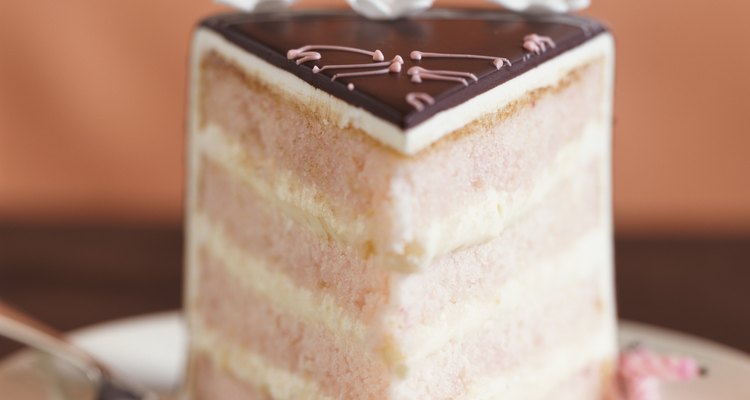What Happens To A Cake If You Put Too Much Baking Soda

Digital Vision./Photodisc/Getty Images
In that location are two schools of thought about how to correct an excess of blistering powder in block batter. One approach says to throw out the block and commencement over. Another advocates adjusting the ingredients until the ratios in the batter come out the same every bit in the original recipe, but that'south a much more difficult procedure.
Chemistry Rules Baking
The "throw it out" arroyo takes into account the chemical effects that blistering pulverisation has on a cake recipe. As a chemical leavener, baking pulverisation combines baking soda with cream of tartar or other acids and an inert starch, usually cornstarch, as a dehumidifier to blot moisture and keep the reaction from happening besides quickly. This combination creates a "double-acting" leavener that works twice, first when moistened and again when heated. The kickoff reaction creates lots of little bubbles in the concoction, while the second reaction causes these bubbles to expand and lift the cake. Using too much baking powder causes a block to rising likewise fast when heated, and so to fall or accept a dense center when it cools. Excess baking pulverisation too gives the cake a bitter gustatory modality. Both effects can't be corrected one time a cake is broiled.
Right the Blistering Formula
The "correct the ratios" approach works if you lot realize at the batter phase that you've added too much baking pulverization. The chemistry of blistering comes into play again considering you're trying to set the "formula" of the block by adjusting the amounts of ingredients. A general rule of baking says that you want about 1 teaspoon of baking pulverization per 1 cup of flour for leavening. This ratio is because cake batter can only agree and then many bubbles before they start to break through the batter surface. Once that happens, it creates channels for lots of other bubbles to break through.
Practice the Baking Math
To correct the ratios, you need to practice the math. First, determine the correct ratio of baking powder to other ingredients in the batter. Let's take an farthermost example. If the recipe calls for 2 cups of flour, the usual ratio of baking powder to flour would be 2 teaspoons. Suppose that you added 2 tablespoons of baking powder past error; that's equivalent to 6 teaspoons of baking powder, since there are three teaspoons in 1 tablespoon. Divide the excess amount (6 tablespoons) by the correct amount (2 teaspoons) and you get a result of 3, significant you've added three times too much baking powder. In order to correct this ratio, you'd need to add three times the amount of flour every bit the original recipe, and so correct all the other ingredients such as sugar, eggs and liquid to rest the flour. It's easy to see how the "correct the ratios" method can rapidly become unwieldy unless y'all're a professional baker or you're making several cakes at home and have room to bake them all at in one case.
Saving a Cake Takes Effort
In the terminate, saving a cake with an excess of baking powder often proves to exist far more attempt than it's worth because of the realities of baking chemistry (unless a large quantity is involved). It would be easier and probably tastier just to throw out a block with too much blistering powder and brand some other.
What Happens To A Cake If You Put Too Much Baking Soda,
Source: https://oureverydaylife.com/can-save-cake-added-much-baking-powder-39084.html
Posted by: whitewasell.blogspot.com


0 Response to "What Happens To A Cake If You Put Too Much Baking Soda"
Post a Comment